![]()
![]()
![]()
Use LEFT and RIGHT arrow keys to navigate between flashcards;
Use UP and DOWN arrow keys to flip the card;
H to show hint;
A reads text to speech;
40 Cards in this Set
- Front
- Back
|
President Bush is successful in passing a $5 billion tax cut. Assume that taxes arefixed, the economy is closed, and the marginal propensity to consume is 0.75. Whathappens to equilibrium GDP? |
There is a $15 billion increase in equilibrium GDP. |
|
|
The multiplier effect is the series of ________ increases in ________ expenditures thatresult from an initial increase in ________ expenditures. |
induced; consumption; autonomous |
|
|
If the federal budget has an actual budget deficit of $100 billion and a cyclicallyadjusted budget deficit of $75 billion, then the economy. |
must be below potential real GDP. |
|
|
Tax reduction and simplification should ________ long-run aggregate supply and________ aggregate demand. |
increase; increase |
|
|
Fiscal policy actions that are intended to have long-run effects on real GDP attemptto increase ________ through changing ________. |
aggregate supply; taxes |
|
|
Double taxation refers to |
corporations paying taxes on profits and individuals paying taxes on dividends. |
|
|
If we include consideration of potential effects of a proposed tax reduction andsimplification on the labor supply, we would expect crowding out of investmentand net exports brought about by the tax cut to be |
less than it would be without the supply-side effects. |
|
|
If tax reduction and simplification are effective, then |
saving and investment in new capital will increase. |
|
|
A recent study by Edward Prescott found that the ________ marginal tax rates in theUnited States relative to Europe resulted in a ________ quantity of labor supplied inthe United States. |
lower; larger |
|
|
Reducing the marginal tax rate on income will |
reduce the tax wedge faced by workers and increase labor supplied. |
|
|
Borrowing to pay for long-lived capital expenditures makes sense as |
the benefits are received over many years so the burden of paying for them should be spread over many years. |
|
|
Government deficits tend to increase during |
periods of war and recession. |
|
|
If the federal government's expenditures are less than its tax revenues, then |
a budget surplus results. |
|
|
The total value of U.S. Treasury bonds outstanding equals |
the federal government debt. |
|
|
Crowding out, following an increase in government spending, results from (theexchange rate is the foreign exchange price of the domestic currency) |
higher interest rates and a higher exchange rate. |
|
|
Poorly timed discretionary policy can do more harm than good. Getting the timingright with fiscal policy is generally |
more difficult than with monetary policy. |
|
|
If policy makers implement an expansionary fiscal policy but do not take intoaccount the potential for crowding out, the new equilibrium level of GDP is likely to |
be below potential GDP. |
|
|
Recent research shows that during recessions, temporarily unemployed people mayexperience improving |
physical health. |
|
|
Increases in government spending result in ________ in the short run, andpermanent increases in government spending result in ________ in the long run. |
partial crowding out; complete crowding out |
|
|
Crowding out will be greater |
the more sensitive investment spending is to changes in the interest rate. |
|
|
A cut in tax rates effects equilibrium real GDP through two channels: ________disposable income and consumer spending, and ________ the size of the multipliereffect. |
increasing; increasing |
|
|
Cutting taxes |
will raise disposable income and raise spending. |
|
|
The tax multiplier |
is negative. |
|
|
An equal increase in government purchases and taxes will cause |
an increase in real GDP. |
|
|
Suppose real GDP is $13 trillion, potential real GDP is $13.5 trillion, and Congressand the president plan to use fiscal policy to restore the economy to potential realGDP. Assuming a constant price level, Congress and the president would need toincrease government purchases by |
less than $500 billion |
|
|
An increase in government purchases of $200 billion will shift the aggregate demandcurve to the right by |
more than $200 billion. |
|
|
In an open economy, the government purchases multiplier will be larger the |
All of the above are correct. |
|
|
Calculate the government purchases multiplier if the marginal propensity toconsume equals 0.8, the tax rate is 0.1, and the marginal propensity to import equals0.2. |
2.1 |
|
|
What is the government purchases multiplier if the tax rate is 0.1 and the marginalpropensity to consume is 0.9? Assume the economy is closed. |
5.3 |
|
|
Assume a closed economy, that taxes are fixed, and the marginal propensity toconsume is equal to 0.8. What is the government spending multiplier? |
5 |
|
|
In an open economy, the government purchases multiplier will be |
smaller as the marginal propensity to import increases. |
|
|
Suppose that Congress allocates $1 billion to clean up after the hurricanes of 2005. Italso raises taxes by $1 billion to keep the deficit from growing. If the marginalpropensity to consume is 0.9, what is the effect on equilibrium GDP? |
GDP increases by $1 billion. |
|
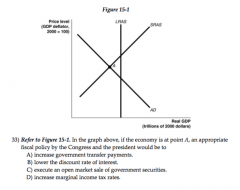
|
increase government transfer payments. |
|
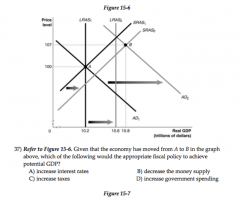
|
increase taxes |
|
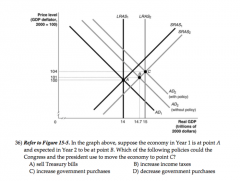
|
increase government purchases |
|
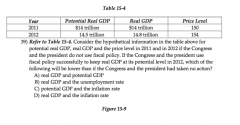
|
real GDP and the inflation rate |
|
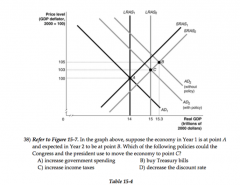
|
increase income taxes |
|
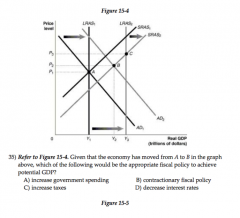
|
increase government spending |
|
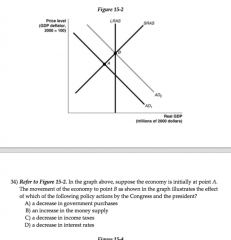
|
a decrease in income taxes |
|
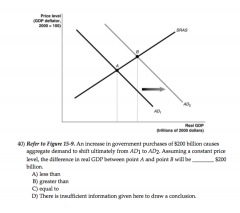
|
B) greater than |

